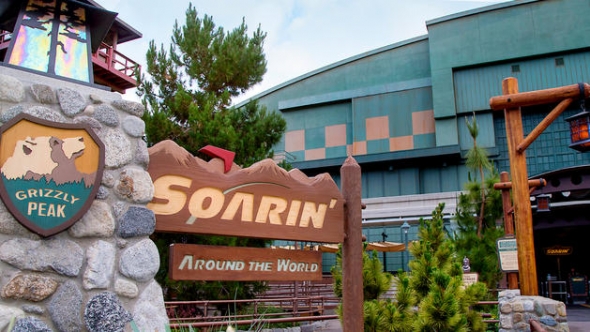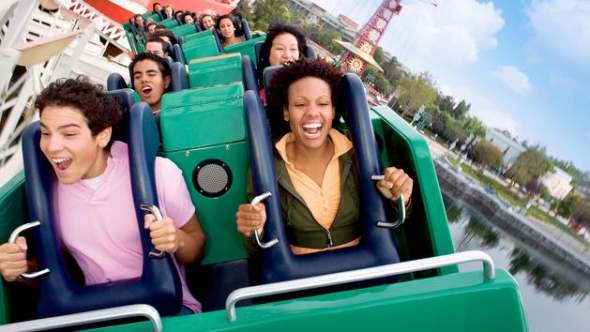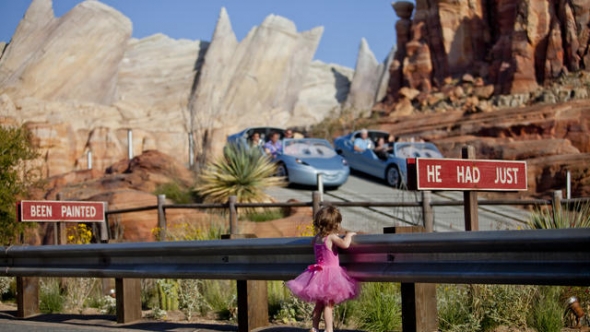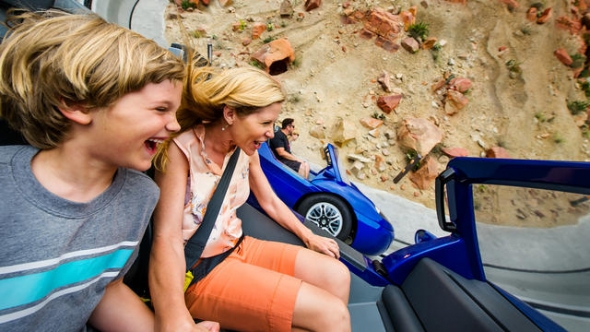Making the best of a bad situation
Image: Disney
So, we’ve come back to the concept that Disney California Adventure was a train wreck at the start, right? Not so fast. Disney did a lot right in the construction of the second Disneyland gate. It just wasn’t in the field of theme park attractions. Don’t get me wrong. Soarin’ and California Screamin’ were instant classics. It’s more that Disney employees prioritized the aspects of the new and improved Disneyland that their boss, Eisner, requested.
Let’s examine Disney’s primary purpose. In building an expansion area, the company wasn’t merely adding a second theme park. That was simply the bait. What they wanted was more money from consumers. The way to get empty the pockets of people didn’t involve rides and attractions inasmuch as new hotels, restaurants, and shopping facilities. You see where I’m going with this.
Image: Disney
Whenever critics deride the launch of Disney California Adventure, they have a tendency to miss the forest for the trees. All that anyone wants to do is mock the failure of Superstar Limo and other attractions that suffered from low attendance. This behavior ignores the lasting aspects of the expansion that have stood the test of time. Disney’s Grand Californian Hotel & Spa quickly became an iconic part of the Disneyland experience, adding more than 1,000 rooms, some of them quite decadent and unconscionably expensive. The hotel also features several restaurants and lounges, including the award-winning Napa Rose.
The seminal addition to the Disneyland Resort expansion, however, is neither a theme park nor lodging. It’s Downtown Disney, the shopping and restaurant mecca that adjoins Disneyland and Disney California Adventure. It’s this series of businesses that elevated Disneyland from a single theme park suffering from lack of enthusiasm due to its age to a multi-day vacation destination area.
With two theme parks and a designated outdoor shopping area, Disney accomplished its primary task, the expansion of a Disneyland vacation for tourists outside the area. Downtown Disney also doubled as a wonderful nightly option for locals and other Californians visiting for the evening. In other words, elevating Disneyland into the Disneyland Resort turned it into more of designation location. It had always stood as the Happiest Place on Earth. The changes simply breathed new life into a decades old theme park.
Making the best of an awkward situation
For several years, Disney California Adventure languished as a wounded animal Disney stubbornly refused to bandage. Disneyland did slightly better, though. They increased in traffic by a million, improving from 12.3 million to 13.3 million during the same timeframe. Part of the explanation for this WAS Disney California Adventure, although it’s hard to demonstrate this through numbers. The second gate started with 5 million in attendance before edging up to 5.6 million. The key was in the multiple day, multiple park tickets Disney sold. They performed exactly as projected, convincing vacationers to spend more time at Disneyland than ever before.
Over time, Disney’s financials improved to the degree that they felt comfortable reinvesting in the Disneyland Resort. That’s how the attractions you know and love today came into being. In 2007, the company committed to a multi-year rebranding of the second gate at Disneyland. They directed $1.1 billion to the reinvention, almost double the initial investment in the park.
The following year, Disney California Adventure added Toy Story Midway Mania!, one of its best and most popular attractions to date. Their signature nighttime show, World of Color, followed in 2010. The prize of the “plussing”, however, wouldn’t arrive until 2012. During that year, Cars Land and its e-ticket attraction, Radiator Springs Racers, debuted.
How effective have these changes worked in luring theme park tourists to Disney California Adventure? In 2007, park traffic amounted to almost 5.7 million visits. The year after Cars Land opened, that number surged to 8.5 million. In 2015, the second gate received roughly 9.4 million visits, almost double what it managed during its shaky first year.
The root of all evil AKA it’s money that matters
Image: Disney
While most critics note that these changes reflect a desperate need to improve something that was broken, I hold a different perspective. I believe that this was always Michael Eisner’s intention. He knowingly took the hit by adding cheap, un-Disney attractions in 2001 in order to expand the Disneyland brand. His plan all along was to spend as little as possible in the short term to build something from nothing.
In the process, Eisner repurposed parking lot space into a viable theme park. He committed little capital to the project in order to protect the short term interests of the company, preventing a corporate vulture from performing a hostile takeover. What he understood was that his company needed to start somewhere. Once they had Disney California Adventure up and running, they could follow the Disney mandate of “plussing” their way to a better tomorrow.
Think of the situation from the business side of Disney. In January of 2000, the price of admission for Disneyland increased from $39 to $41. When Disney California Adventure opened 13 months later, it cost $48 for single-day admission. What Disney was really pushing, however, is what I’ve mentioned above. They wanted to sell a multi-day park hopper ticket, encouraging theme park tourists to stay longer. Today, that ticket costs more than $250 for three days of park hopping at Disneyland Resort. A single day of admission is roughly $100. If the company had simply increased at the same inflationary rate for 15 years, a Disneyland ticket would cost $55.62. That extra money is possible due to the existence of an expanded Disneyland campus.
Over the course of 15 years, Disney effectively persuaded guests to pay $250 during a multi-day stay at their campus rather than $41 for a single-day at Disneyland. Now consider the accompanying numbers. Disneyland itself claimed 12.3 million visits in 2001. In 2015, the two parks enjoyed 27.7 million worth of traffic. Expanding the Disneyland campus more than doubled overall park attendance as guests paid a factor somewhere between 2.5 and 6 more for tickets. And that’s not including the increased shopping, meal, and resort revenue. What Eisner did stabilized The Walt Disney Company during a time of dramatic corporate upheaval. The company went from being ripe for hostile takeover to its current status as the most powerful brand in the world.
Think of Disney California Adventure like a child. It struggled in learning to walk, but it’s now evolved into a talented teenager with an extremely bright future. Its early days get a bad rap since they’re judged against the entire history of Disney theme parks. If you evaluate the expansion as a business venture, however, it’s proven extremely lucrative.





Comments
You said...
"We expect the most out of Disney, and we consider it our duty to protect the brand even though we’re technically unaffiliated with it. "
And I personally think this is in error, we are very much affiliated with the parks and the brand. We may not be stock holders (actually I am) but we are stakeholders. Our money is what keeps the parks going and since we visit and spend our money voluntarily we have the right to demand the best from the parks and company.
Currently (mid 2017) Disneyland is packing in the cheap customers to shoulder to shoulder levels and this along with all of the construction is hurting the park and it's image with tourists..
I first visited California Adventure during a pre-opening preview. Although I was excited to get a chance to see the park before the general public, it was obvious from the start that it was somewhat confused. Between Mondavi wines and carnival style vomit rides, it was hard to understand who the customer was supposed to be. Of course, the whole thing has improved dramatically since then, but I think it's telling that I visited once in early 2001, then didn't come again until 2015.
To my thinking, Disney has opened three sub-par parks: California Adventure, Disneyland Hong Kong, and Disney Studio Paris. Today, California Adventure is a terrific park and getting better. The Hong Kong park was expanded and is now a very nice "small" Disney park with two world class attractions: Mystic Manor and Grizzly Run. Iron Man is coming. The only Disney park I would still rank sub-par is Disney Studio Paris. They need a few more Remy's Great Escape to bring the park up to what is should be.
Great article and nice argument. I agree Eisner expanded the Disneyland brand into a resort, but I disagree that once "Disney's California Adventure [was] up and running, they could follow the Disney mandate of “plussing” their way to a better tomorrow." Michael Eisner lost his job and legacy over his “taking the hit by adding cheap, un-Disney attractions.”
The strategy worked for Eisner in Walt Disney World with Hollywood Studios, Animal Kingdom, Downtown Disney, hotels and Disney Vacation Club – but it decidedly failed in Anaheim and Paris. Walt Disney Studios was built on the cheap to expand the Disneyland Paris Resort, but one could argue the whole resort remains a failure, despite trying to duplicate the same game plan: add a second gate (on the cheap for a foundation) and invest later. The “plussing” of Tower of Terror, Ratatouille, and other investments (or lack of maintenance over the years) has decidedly made the Disneyland Paris brand weaker, not stronger, and is still a topic of debate.
I’m not sure Michael Eisner would have had the strength of courage to make the investments of Bob Iger: purchase Pixar, Marvel, Star Wars and invest $1.1 billion in California Adventure, $5.5 billion in Shanghai. Learning from Disneyland Tokyo Resort – I think it’s a better argument a second gate should not be built unless up to Disney standards.
Eisner could very well have expanded the Disneyland “resort” with Downtown Disney, new hotels, and new lands at Disneyland… people would have still come. Universal Studios in Hollywood seems to be doing just fine with the expansion of Simpsons, Minions, Harry Potter and CityWalk upgrades, without the need for a second gate. Likewise, Hong Kong Disneyland is building a third hotel and is clearly expanding into a “resort” without a second gate but with expanded options for overnight guests.
We did not need the cheap version of California Adventure to increase the Disneyland brand. If anything, the Disney and Disneyland brand were both hurt (as reflected in a stagnant stock price for years) by a cheap theme park, and was only saved with an unprecedented level of investment. It wasn't just "plussing" the park, the entire front section of the park gutted, rebuilt and rethemed, and other lands are being reinvented. Now if only they could rebuild Walt Disney Studios (like Hollywood Studios).
But back to the Disneyland Resort, with Star Wars Land and the new high-end hotel confirmed, and rumors of more Marvel and Frozen attractions, we can agree the Disneyland brand looks bright.